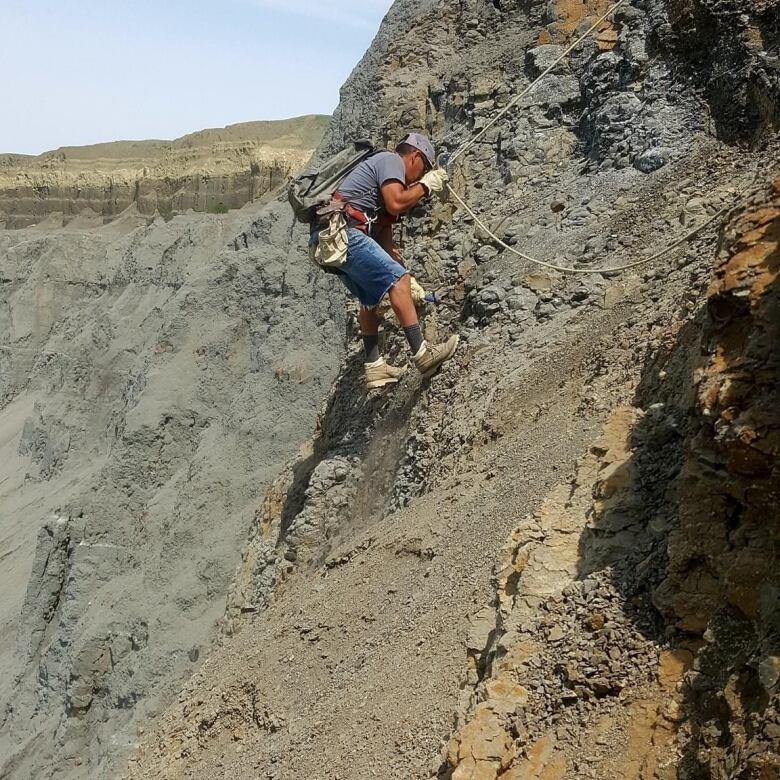Blood reserve rockhunter brings iridescent fossil shells 'back to the world'
Wes Eaglechild collects ammolite, also called iniskim or 'buffalo calling stones'

Wes Eaglechild is a cliffhanger,rappellingdownriverside escarpmentsto collectmillion-year-old stones known as ammolite.
Eaglechild,from Blood Tribe reserve 148, has been rock collectingsince receiving his SurfaceMining Collection permit from the community about 180 kilometres south of Calgary a decade ago.
"Once you find something and you see that gem, that colour on it it's almost like this old creature ammonite has been reborn after 75 million years and you're bringing it back to the world."
Ammoliteis an iridescent rock made from ammonite fossils,ancient marine animals that went extinct at the same time as the dinosaurs. They were sea-dwelling creatures closely related to octopuses and squids.
Eaglechild mines throughout the year, in rain and winter conditions alongriversidecliffs that can be as high as 150 metres.A pick-hammer and a shovel aresome of the tools he carries with him. He scours the face of the cliff, searching for "poke-outs,"fossil edges that might contain thegems he's out there to find.
"I like to come out here early so I can beat the heat,beat the rush," he said.
"Basically, try to be the first one out here."

Andrea Girolami, from Siksika Nation and Eaglechild's long-time partner, ventures on-site when she can.
Girolamisaid she has a fear of heights but watching Eaglechild at work helped.
"It kind of helped me overcome my fear of heights. It didn't take me long before I was hiking down those cliffs, too."
Ammonites are found in the Bearpaw Formation, a geological formation created by the sediment of an ancient sea.
Donald Henderson, curator of dinosaurs at the Royal Tyrrell Museum near Drumheller, Alta.,saidthe seaway dates back to between 100 million and 66 million years.
"At its peak, you could have paddled your canoe from the Arctic Ocean down to the Gulf of Mexico," he said.
Ammonites had distinctive shells, coiled in shape, about 60centimetres in diameter. They were born with a small, soft shell on their back which they spiraled out ofas they grew.
"They were victims of the same event that killed off the dinosaurs, so the asteroid impact is the best explanation for this mass extinction," he said.
In Alberta, the fossilized shells developed a rainbow colour due to unique geological activity. It's called structural colour, producing violets, greens and purples.
"They've been cooked just right to give them all the colours and that iridescence that they have," said Henderson.
The stones are also part of cultural teachingsin Siksikaitsitapi (Blackfoot Confederacy) territory. They are sometimes referred to as iniskim, or buffalo calling stones.
In ashortened and shared version of a traditional Blackfoot legend,Brown Weasel woman was called to by a rock near the river. It said to wrap it in sacred medicines and offer prayer. In turn, the rock would bring prosperity to the people.

Charlene Bruised Head-Mountain Horse, anIndigenous Student Advisor at theUniversity of Lethbridge, said learning about the iniskim ispart of helping students grow at any stage of their life.
"It is important to know the significance because I've been taught we rely on the iniskim."
Bruised Head-Mountain Horse, a former member of the Buffalo Women (Moato'kiks) society,guides students on the balance between oneself, ancestors and "pretty much the survival of our people."
She saidshe also learns teachings from her daughter, who is a carrier of a traditional iniskim stone.
"We have very unique youth and young people who are gifted and I take that into consideration. Residential school impacted how we learn and some of our traditional ways of knowing."












_(720p).jpg)


 OFFICIAL HD MUSIC VIDEO.jpg)
.jpg)



























































































